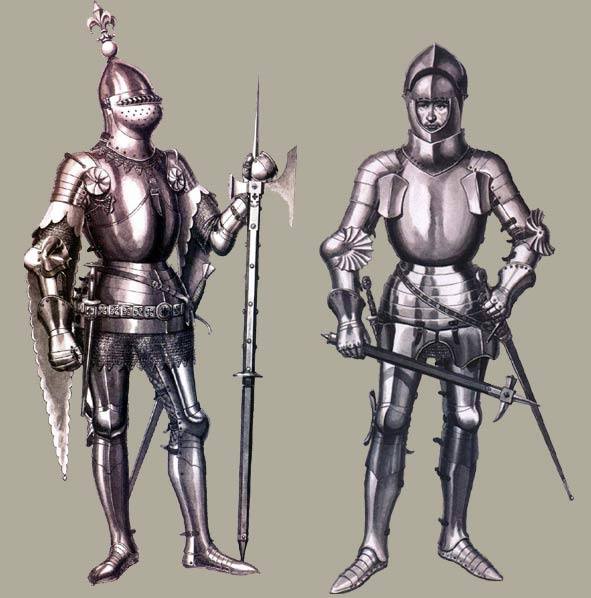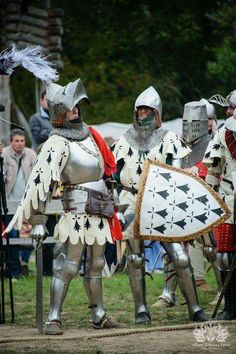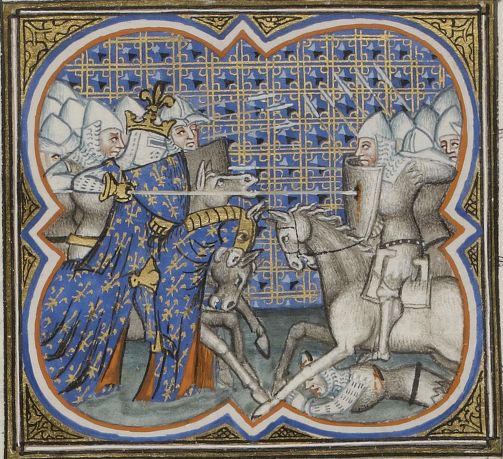| Author |
Message |
Pedro Paulo Gaião

|
 Posted: Mon 28 Mar, 2016 1:46 pm Post subject: What kind of heraldic adornment is this? (help from XVth c.) Posted: Mon 28 Mar, 2016 1:46 pm Post subject: What kind of heraldic adornment is this? (help from XVth c.) |
 |
|
Could anyone help me with it? I would like to know its name, in which time it was used and where it was used
 Attachment: 45.32 KB Attachment: 45.32 KB

 Attachment: 24.76 KB Attachment: 24.76 KB

|
|
  |
 |
Shahril Dzulkifli

|
 Posted: Tue 29 Mar, 2016 7:02 am Post subject: What kind of heraldic adornment is this? (Help from XVth c.) Posted: Tue 29 Mar, 2016 7:02 am Post subject: What kind of heraldic adornment is this? (Help from XVth c.) |
 |
|

Interesting. But I can't figure out what symbol is that on the shield.
“You have power over your mind - not outside events. Realize this, and you will find strength”
- Marcus Aurelius
|
|
  |
 |
|
Mart Shearer
|
 Posted: Tue 29 Mar, 2016 8:12 am Post subject: Posted: Tue 29 Mar, 2016 8:12 am Post subject: |
 |
|
The crests on the bascinets, or the arms on the shield?
The arms on the shield in the second photo are for the Dukes of Brittany, and represent ermine, with the black spots symbolizing the black tips of the tails on the white winter coat.

The second is an ostrich plume.
http://manuscriptminiatures.com/4121/8429/

The first image is a fleur-de-lis crest, which was frequently used by the French royalty. The 1421 inventory of King Charles VI mentions one:
Premièrement, un bacinet d'acier doré de fin or, à une double fleur de lis de cuivre doré hachée, pour mectre dessus ledit bacinet, dont fault le camail, qui estoit de jaseran, comme il appert par le précédent inventoire.
(First, a steel bascinet, gilt with fine gold, with a double fleur-de-lis with gilt copper hatching as a crest, with the camail, which was listed as being of jazerant per the preceding inventory.)
 Attachment: 79.53 KB Attachment: 79.53 KB

BNF Français 2813, fo.355v
ferrum ferro acuitur et homo exacuit faciem amici sui
|
|
  |
 |
Greyson Brown

|
 Posted: Tue 29 Mar, 2016 8:57 am Post subject: Posted: Tue 29 Mar, 2016 8:57 am Post subject: |
 |
|
If you are referring to the the sleeve-type garment, that is probably a cote-hardie with tippet sleeves. The body of the cote-hardie was fairly tight fitted and could be quite short or rather long, so a short bodied cote-hardie may explain why the hem is not visible in the first image. I would generally expect to see the hem as you can in the image of the re-enactors. Tippet sleeves (which essentially stop near the elbow but have a tail extending down from them) were, to the best of my recollection, more of a 14th century fashion than 15th century. That said, their use may have continued later than I realized, especially in specific regions.
-- Grey
"So long as I can keep the path of honor I am well content."
-Sir Arthur Conan Doyle, The White Company
|
|
  |
 |
Pedro Paulo Gaião

|
 Posted: Sun 15 May, 2016 9:01 am Post subject: Posted: Sun 15 May, 2016 9:01 am Post subject: |
 |
|
| Greyson Brown wrote: | If you are referring to the the sleeve-type garment, that is probably a cote-hardie with tippet sleeves. The body of the cote-hardie was fairly tight fitted and could be quite short or rather long, so a short bodied cote-hardie may explain why the hem is not visible in the first image. I would generally expect to see the hem as you can in the image of the re-enactors. Tippet sleeves (which essentially stop near the elbow but have a tail extending down from them) were, to the best of my recollection, more of a 14th century fashion than 15th century. That said, their use may have continued later than I realized, especially in specific regions.
-- Grey |
that was what I wanted to know, thanks
| Mart Shearer wrote: | The first image is a fleur-de-lis crest, which was frequently used by the French royalty. The 1421 inventory of King Charles VI mentions one:
Premièrement, un bacinet d'acier doré de fin or, à une double fleur de lis de cuivre doré hachée, pour mectre dessus ledit bacinet, dont fault le camail, qui estoit de jaseran, comme il appert par le précédent inventoire.
(First, a steel bascinet, gilt with fine gold, with a double fleur-de-lis with gilt copper hatching as a crest, with the camail, which was listed as being of jazerant per the preceding inventory.) |
Jazerant wouldn't be a type of islamic armour? a hauberk between layers of aketon (or al-qutun)
|
|
  |
 |
|
Mart Shearer
|
 Posted: Sun 15 May, 2016 10:05 am Post subject: Posted: Sun 15 May, 2016 10:05 am Post subject: |
 |
|
Jazerant originated in the Middle East, either Arabic or Persian, but was adopted by the Europeans by the 12th century. It is constructed the same, with mail and associated padding between layers of cloth.
http://willscommonplacebook.blogspot.com/2008/05/jesseraunts.html
ferrum ferro acuitur et homo exacuit faciem amici sui
|
|
  |
 |
Pedro Paulo Gaião

|
 Posted: Fri 27 May, 2016 7:01 am Post subject: Posted: Fri 27 May, 2016 7:01 am Post subject: |
 |
|
Adopted by europeans in 12th century? But then why we not see anything like a jazerant in contemporary art until 14th century, where you actually see paddings over mail armour? Still, you could even say it's just a Jupon on the armor of the time, and not necessarily a jazerant like this illustration:

|
|
  |
 |
|
Lafayette C Curtis
|
 Posted: Tue 31 May, 2016 11:00 am Post subject: Posted: Tue 31 May, 2016 11:00 am Post subject: |
 |
|
|
Because if the jazerant was made with mail sandwiched between two (or more) layers of cloth, the mail might be entirely encapsulated within the cloth and wouldn't be visible at all from the outside. Some of the examples of padded/quilted armour we see from the 12th and 13th centuries might well be jazerants instead of all-fabric jacks/gambesons/aketons.
|
|
  |
 |
Pedro Paulo Gaião

|
 Posted: Wed 23 Nov, 2016 2:28 pm Post subject: Posted: Wed 23 Nov, 2016 2:28 pm Post subject: |
 |
|
| Lafayette C Curtis wrote: | | Because if the jazerant was made with mail sandwiched between two (or more) layers of cloth, the mail might be entirely encapsulated within the cloth and wouldn't be visible at all from the outside. Some of the examples of padded/quilted armour we see from the 12th and 13th centuries might well be jazerants instead of all-fabric jacks/gambesons/aketons. |
But do we have evidence of knights, sergeants or nobles using gambersons over their armor by this time? Only the gamberson being shown would suffice, since no nobleman would go to war with only paddings to protect himself. Also, mail itself wasn't exactly an armor accessible to the more common soldiers at that time, and the jazerant seems to sound like something even more elitist than mail at this time, especially to Muslims. That said, I would say the is no real point guessing if a common soldier is wearing a jazerant or not. I might be wrong on that, anyways.
Also, european jazerant was quilted/lined between the mail or it was simply paddings+mail+paddings in different pieces?
About the tippet sleeves, I find some pictures showing them, all from 15th century :

Source: http://manuscriptminiatures.com/4818/13512/
By the way, that is the name of this helmets?
Others:
Source: http://demonagerie.tumblr.com/post/3184788599...-f44v-mars
Source: http://discardingimages.tumblr.com/post/13757...ours-ghent
|
|
  |
 |
|
Gregory J. Liebau
Location: Dinuba, CA Joined: 27 Nov 2004
Posts: 669
|
 Posted: Wed 23 Nov, 2016 8:58 pm Post subject: Posted: Wed 23 Nov, 2016 8:58 pm Post subject: |
 |
|
Pedro, no one's saying that there are jazerants in any of the images posted here. Mart originally translated a text for you while referencing the fleur-de-lis crest in one of the paintings.
My Flickr Galleries - Travel, Nature & Things
|
|
  |
 |
|
Raman A
Location: United States Joined: 25 Aug 2011
Posts: 148
|
 Posted: Thu 01 Dec, 2016 3:45 am Post subject: Posted: Thu 01 Dec, 2016 3:45 am Post subject: |
 |
|
| Greyson Brown wrote: | ...to the best of my recollection, more of a 14th century fashion than 15th century. That said, their use may have continued later than I realized, especially in specific regions.
-- Grey |
The cotehardie with tippet sleeves morphed into the houppelande around 1400, so it's probably that. Although, houppelande sleeves are generally arm-length and the garment is baggier around the torso. Maybe they stuck with an older style for practical reasons?
Here's another example I found:

http://manuscriptminiatures.com/4386/8764/
|
|
  |
 |
|
Lafayette C Curtis
|
 Posted: Mon 19 Dec, 2016 1:38 pm Post subject: Posted: Mon 19 Dec, 2016 1:38 pm Post subject: |
 |
|
| Pedro Paulo Gaião wrote: | | But do we have evidence of knights, sergeants or nobles using gambersons over their armor by this time? Only the gamberson being shown would suffice, since no nobleman would go to war with only paddings to protect himself. |
This translated excerpt shows that sometimes even prominent nobles would go into a fight wearing nothing more than fabric (presumably padded or quilted) armour without taking the time to put on their mail:
http://deremilitari.org/2013/02/siege-of-burr...conqueror/
| Quote: | | Also, mail itself wasn't exactly an armor accessible to the more common soldiers at that time, |
Europe was rapidly growing in wealth during the 12th and 13th centuries and mail was quickly becoming more affordable than in previous eras. By 1302 or 1304 or so, the entire first rank of the Flemish urban militia at Courtrai might have been dressed in mail.
| Quote: | | Also, european jazerant was quilted/lined between the mail or it was simply paddings+mail+paddings in different pieces? |
To qualify as "jazerant," they probably would have had to be made up as a single garment rather than separate components.
|
|
  |
 |
Pedro Paulo Gaião

|
 Posted: Sat 16 Sep, 2017 11:18 am Post subject: Posted: Sat 16 Sep, 2017 11:18 am Post subject: |
 |
|
Even if the sleeves are tight, is it still possible to use the articulated pieces that protect joins in the elbow and shoulders? In the file at the bottom, from Froissart's Chronicles, there are men-at-arms with different types of clothes over their armor, but I don't think its likely there were plate pieces under the clothes for it would complicate the movements. When I actually see those pieces, there were worn over the cloth. That said, it's safe to assume that, when using such garments, the wearer would have only mail as underneath defenses? These sets, for example, doesn't seen to have shoulder pieces:
https://ru.pinterest.com/pin/157344580714875424/
https://ru.pinterest.com/pin/84231455508075773/
https://ru.pinterest.com/pin/110971578288617944/
Using clothes over armor can achieve some relevant extra-protection or its simply stylistic? This padded dress, for example, seens to have defensive properties (I have seen some manuscript illuminatures related to this, mainly from Chronicles de Angleterre and Froissart's Chronicles). There is a primary source also describing a cerimony where King Ferdinand the Catholic was wearing padded clothes covered with brocade over his armor; his noblemen were similarly armed "in french fashion".

And by the way, what's the name of this type of sleeves? I have seen it in burgundian pictures, generally
https://www.outfit4events.com/runtime/cache/images/redesignProductFull/mna_1052.JPG
 Attachment: 122.65 KB Attachment: 122.65 KB

“Burn old wood, read old books, drink old wines, have old friends.”
Alfonso X, King of Castile (1221-84)
|
|
  |
 |
|
|
You cannot post new topics in this forum
You cannot reply to topics in this forum
You cannot edit your posts in this forum
You cannot delete your posts in this forum
You cannot vote in polls in this forum
You cannot attach files in this forum
You can download files in this forum
|
All contents © Copyright 2003-2025 myArmoury.com — All rights reserved
Discussion forums powered by phpBB © The phpBB Group
Switch to the Basic Low-bandwidth Version of the forum
|

